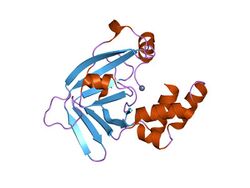Biology:ZinT protein domain
| ZinT | |||||||||
|---|---|---|---|---|---|---|---|---|---|
 Crystal structure of metal-binding protein YodA from E. coli, PFAM DUF149 | |||||||||
| Identifiers | |||||||||
| Symbol | ZinT | ||||||||
| Pfam | PF09223 | ||||||||
| Pfam clan | CL0116 | ||||||||
| InterPro | IPR015304 | ||||||||
| SCOP2 | 1oej / SCOPe / SUPFAM | ||||||||
| |||||||||
In molecular biology, ZinT (formerly known as YodA) is a family of protein domains found in prokaryotes. The domain contains a single binding site that can accommodate a divalent cation, with a geometry suggestive of zinc binding. This family was first thought to be part of the bacterial response to a toxic heavy metal cadmium by binding to the metal to ensure its elimination;[1] however, more recent work has suggested a role in zinc homeostasis.[2]
Function
There is strong evidence for involvement of the ZinT domain in zinc homeostasis and management of zinc in the periplasm.[2][3] It may also facilitate zinc uptake from the environment through interactions with the znuABC zinc transporter.[3][4][5] It is regulated by the metalloregulator gene Zur (zinc uptake regulator).[2][5]
The domain was originally discovered in the bacterial stress response to cadmium. Further studies have found that it binds to cadmium, zinc, nickel, and mercury, but not other common metals such as cobalt, copper, iron, and manganese.[1][6] It may have a secondary function in managing heavy-metal toxicity.[7]
References
- ↑ 1.0 1.1 "YodA from Escherichia coli is a metal-binding, lipocalin-like protein". J. Biol. Chem. 278 (44): 43728–35. October 2003. doi:10.1074/jbc.M304484200. PMID 12909634.
- ↑ 2.0 2.1 2.2 Graham, AI; Hunt, S; Stokes, SL; Bramall, N; Bunch, J; Cox, AG; McLeod, CW; Poole, RK (3 July 2009). "Severe zinc depletion of Escherichia coli: roles for high affinity zinc binding by ZinT, zinc transport and zinc-independent proteins.". The Journal of Biological Chemistry 284 (27): 18377–89. doi:10.1074/jbc.m109.001503. PMID 19377097.
- ↑ 3.0 3.1 Ilari, A; Alaleona, F; Tria, G; Petrarca, P; Battistoni, A; Zamparelli, C; Verzili, D; Falconi, M et al. (January 2014). "The Salmonella enterica ZinT structure, zinc affinity and interaction with the high-affinity uptake protein ZnuA provide insight into the management of periplasmic zinc.". Biochimica et Biophysica Acta (BBA) - General Subjects 1840 (1): 535–44. doi:10.1016/j.bbagen.2013.10.010. PMID 24128931.
- ↑ Petrarca, P; Ammendola, S; Pasquali, P; Battistoni, A (March 2010). "The Zur-regulated ZinT protein is an auxiliary component of the high-affinity ZnuABC zinc transporter that facilitates metal recruitment during severe zinc shortage.". Journal of Bacteriology 192 (6): 1553–64. doi:10.1128/jb.01310-09. PMID 20097857.
- ↑ 5.0 5.1 Blindauer, CA (18 March 2015). "Advances in the molecular understanding of biological zinc transport.". Chemical Communications 51 (22): 4544–63. doi:10.1039/c4cc10174j. PMID 25627157. http://wrap.warwick.ac.uk/76059/1/WRAP_Blindauer_C4CC10174J.pdf.
- ↑ "Zinc dependence of zinT (yodA) mutants and binding of zinc, cadmium and mercury by ZinT.". Biochem Biophys Res Commun 364 (1): 66–71. 2007. doi:10.1016/j.bbrc.2007.09.094. PMID 17931600.
- ↑ Colaço, HG; Santo, PE; Matias, PM; Bandeiras, TM; Vicente, JB (13 January 2016). "Roles of Escherichia coli ZinT in cobalt, mercury and cadmium resistance and structural insights into the metal binding mechanism.". Metallomics 8 (3): 327–36. doi:10.1039/c5mt00291e. PMID 26758285.
 |

